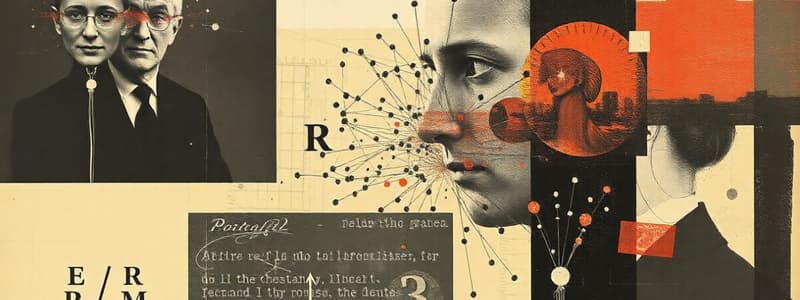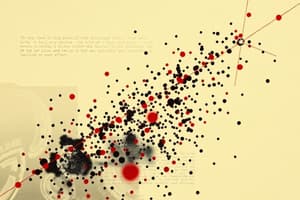Podcast
Questions and Answers
What does a correlation coefficient of r = 0.97 indicate about the relationship between two variables?
What does a correlation coefficient of r = 0.97 indicate about the relationship between two variables?
- The variables are independent of each other.
- There is no linear relationship between the variables.
- There is a strong positive correlation. (correct)
- There is a moderate negative correlation.
How is the variance accounted for by Pearson’s r calculated?
How is the variance accounted for by Pearson’s r calculated?
- By taking the square root of the correlation coefficient.
- By adding the values of X and Y together.
- By multiplying the standard deviations of two variables.
- By squaring the value of Pearson's r. (correct)
If the squared Pearson's r is close to 1, what does this signify regarding the variables?
If the squared Pearson's r is close to 1, what does this signify regarding the variables?
- The variables do not have a significant relationship.
- The variables are normally distributed.
- The relationship between the variables is weak.
- The variables explain most of the variability in the data. (correct)
In the context of correlation, what does a value of r = -0.85 suggest?
In the context of correlation, what does a value of r = -0.85 suggest?
What must be true about the data for Pearson’s r to be a suitable correlation measure?
What must be true about the data for Pearson’s r to be a suitable correlation measure?
Which statement is true regarding partial correlations?
Which statement is true regarding partial correlations?
If variable A correlates with variable B and variable C affects both A and B, which concept explains this situation?
If variable A correlates with variable B and variable C affects both A and B, which concept explains this situation?
What is the expected correlation coefficient between two perfectly correlated variables?
What is the expected correlation coefficient between two perfectly correlated variables?
Which of the following is NOT a characteristic of Pearson’s correlation coefficient?
Which of the following is NOT a characteristic of Pearson’s correlation coefficient?
Which method can be used to visually represent the correlation between two continuous variables?
Which method can be used to visually represent the correlation between two continuous variables?
What does variance accounted for indicate in the context of correlation?
What does variance accounted for indicate in the context of correlation?
Which of the following statements regarding variance accounted for is true?
Which of the following statements regarding variance accounted for is true?
How is variance accounted for typically expressed in statistical terms?
How is variance accounted for typically expressed in statistical terms?
When evaluating the significance of variance accounted for, what does a higher value signify?
When evaluating the significance of variance accounted for, what does a higher value signify?
Which correlation measurement can lead to a calculation of variance accounted for?
Which correlation measurement can lead to a calculation of variance accounted for?
In a study where a variance accounted for of 75% is reported, what does this suggest?
In a study where a variance accounted for of 75% is reported, what does this suggest?
If the variance accounted for in a study is reported as 0.4, what can be inferred?
If the variance accounted for in a study is reported as 0.4, what can be inferred?
What is one limitation of relying solely on variance accounted for?
What is one limitation of relying solely on variance accounted for?
What can be a consequence of misinterpreting variance accounted for as a direct measure of causation?
What can be a consequence of misinterpreting variance accounted for as a direct measure of causation?
To establish a relationship between two variables, what is essential apart from variance accounted for?
To establish a relationship between two variables, what is essential apart from variance accounted for?
What does a positive covariance indicate about the relationship between two variables?
What does a positive covariance indicate about the relationship between two variables?
Which of the following statements best represents the limitations of correlation analysis?
Which of the following statements best represents the limitations of correlation analysis?
What is the range of possible values for Pearson's r?
What is the range of possible values for Pearson's r?
How does Spearman’s rank correlation differ from Pearson's coefficient of correlation?
How does Spearman’s rank correlation differ from Pearson's coefficient of correlation?
In correlation analysis, what does a value of zero signify?
In correlation analysis, what does a value of zero signify?
What can the presence of a null effect in a correlation analysis suggest?
What can the presence of a null effect in a correlation analysis suggest?
What is one primary characteristic of a correlation's magnitude?
What is one primary characteristic of a correlation's magnitude?
Which of the following best describes the best fit line in a correlation context?
Which of the following best describes the best fit line in a correlation context?
What does a negative correlation imply about two variables?
What does a negative correlation imply about two variables?
In correlation studies, what does the term 'variance accounted for' refer to?
In correlation studies, what does the term 'variance accounted for' refer to?
What is a key feature of Spearman’s Rho correlation coefficient compared to Pearson’s correlation coefficient?
What is a key feature of Spearman’s Rho correlation coefficient compared to Pearson’s correlation coefficient?
What is the purpose of squaring Pearson's r when evaluating variance accounted for?
What is the purpose of squaring Pearson's r when evaluating variance accounted for?
What characteristic of Pearson's r makes it independent of overall variability?
What characteristic of Pearson's r makes it independent of overall variability?
What must be true for the Pearson's correlation coefficient to be appropriately used?
What must be true for the Pearson's correlation coefficient to be appropriately used?
What does a correlation value of r = -0.67 indicate regarding the relationship of X and Y?
What does a correlation value of r = -0.67 indicate regarding the relationship of X and Y?
Which of the following computations does Spearman’s Rho correlate?
Which of the following computations does Spearman’s Rho correlate?
In the context of reporting correlation coefficients, what does a notation r(8) = 0.97, p < 0.001 suggest?
In the context of reporting correlation coefficients, what does a notation r(8) = 0.97, p < 0.001 suggest?
When a correlation value is squared, what does that value represent?
When a correlation value is squared, what does that value represent?
How is a positive correlation described in terms of the relationship between two variables?
How is a positive correlation described in terms of the relationship between two variables?
Why might partial correlations be considered in the analysis of two variables?
Why might partial correlations be considered in the analysis of two variables?
Which factor is NOT a requirement for conducting correlation analysis in SPSS?
Which factor is NOT a requirement for conducting correlation analysis in SPSS?
Flashcards
Correlation
Correlation
A statistical measure that quantifies the strength and direction of the linear association between two variables.
Pearson's r
Pearson's r
A type of correlation coefficient that measures the linear relationship between two continuous variables. It ranges from -1 to +1.
Covariance
Covariance
A statistical measure that describes the extent to which two variables change together. It can be positive, negative, or zero.
Spearman's Rho
Spearman's Rho
Signup and view all the flashcards
Variance Accounted For
Variance Accounted For
Signup and view all the flashcards
Null Effect
Null Effect
Signup and view all the flashcards
T-Test
T-Test
Signup and view all the flashcards
Association
Association
Signup and view all the flashcards
Causation
Causation
Signup and view all the flashcards
Correlation Significance
Correlation Significance
Signup and view all the flashcards
Pearson's Correlation Coefficient (r)
Pearson's Correlation Coefficient (r)
Signup and view all the flashcards
Spearman's Rho Correlation Coefficient
Spearman's Rho Correlation Coefficient
Signup and view all the flashcards
Scatter Plot
Scatter Plot
Signup and view all the flashcards
Perfect Correlation (+1 or -1)
Perfect Correlation (+1 or -1)
Signup and view all the flashcards
Smaller Correlation Coefficient (e.g., 0.153)
Smaller Correlation Coefficient (e.g., 0.153)
Signup and view all the flashcards
No Linear Relationship (r = 0)
No Linear Relationship (r = 0)
Signup and view all the flashcards
Partial Correlation
Partial Correlation
Signup and view all the flashcards
Correlation in SPSS
Correlation in SPSS
Signup and view all the flashcards
Reporting a Correlation Coefficient
Reporting a Correlation Coefficient
Signup and view all the flashcards
Pearson's Correlation Coefficient
Pearson's Correlation Coefficient
Signup and view all the flashcards
Perfect Positive Correlation
Perfect Positive Correlation
Signup and view all the flashcards
Perfect Negative Correlation
Perfect Negative Correlation
Signup and view all the flashcards
Null Relationship
Null Relationship
Signup and view all the flashcards
Study Notes
Overview of Correlations
- Correlations measure the relationship between two variables
- Correlation analysis explores the strength and direction of a linear relationship
- Variables are examined for covariance, correlation, and variance accounted for
- This analysis does not imply causality
Types of Correlation
- Pearson's r: Used for continuous variables; measures the linear relationship between two variables
- Spearman's Rho: Used for ordinal or ranked data; measures the monotonic relationship between two variables
Covariance
- Covariance measures the directional relationship (positive or negative) between two variables
- A positive value indicates variables tend to change in the same direction
- A negative value indicates variables tend to change in opposite directions
- Covariance is a way to understand the relationship before any standardization
- Covariance values cannot be directly compared due to scale variation across datasets
Scatterplots
- Scatterplots graphically represent the relationship/association between two variables
- Each plotted data point represents a data pair for the two variables
- Scatterplots visualise the general direction of a relationship between two variables
- Excel and other software are used to create scatterplots quickly
Reporting Correlations
- Correlation reports contain values for different correlation types
- Key statistics often include correlation coefficients, degrees of freedom, and significance levels
- Examples of correlation reporting in SPSS are provided and include the format
Calculating Variance Explained
- Variance explained shows how much of the variation in one variable can be predicted by the other variable
- The amount of variance explained is calculated by squaring the correlation coefficient
- If this value is close to 1, it means that the variables are very closely related
- Values closer to zero means the variables are less related
Significance and Magnitude
- A value of 1 or -1 indicates a strong linear relationship between two variables
- A value of zero indicates no relationship between the two variables
- Significance is assessed statistically and helps determine how likely the result would happen by chance
- Significance is often reported as a p-value, indicating the probability of obtaining the results by chance
- Significance levels such as p < .05 or p < .01 indicates statistical significance at a given level
Partial Correlations
- Explore the association between two variables holding other variables constant
- Examining the relationship between variables without the influence of a confounding variable
- Used to isolate the specific relationship of interest between variables, adjusting for other factors
- Help uncover hidden patterns in data, offering deeper insights
- Partial correlations are calculated by adjusting for the effect of other variables.
Correlation in SPSS
- SPSS is a statistical software used to perform correlation analyses
- Correlation analysis in SPSS can be used to analyze the association between two or more variables
- SPSS is used for creating detailed correlations, identifying statistically significant relationships, and determining if results came from chance or true variables
- Specific steps in SPSS for running correlations are demonstrated in diagrams
Studying That Suits You
Use AI to generate personalized quizzes and flashcards to suit your learning preferences.
Related Documents
Description
This quiz explores the fundamentals of correlation analysis, focusing on the relationship between two variables. It covers key concepts such as Pearson's r and Spearman's Rho, along with covariance and its directional implications. Test your understanding of these statistical concepts and their applications.




